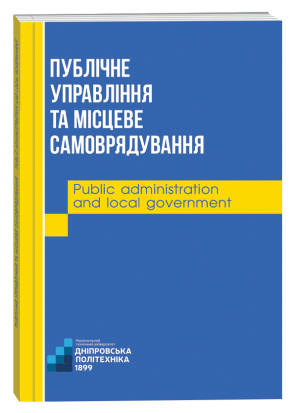КРЕАТИВНІ КОВОРКІНГИ ЯК ІНСТРУМЕНТ ФОРМУВАННЯ УРБАНІСТИЧНОГО ПОРТРЕТУ РЕГІОНУ ТА ДЖЕРЕЛО «ПУЛУ ТАЛАНТІВ»
DOI:
https://doi.org/10.32782/2414-4436/2023-3-10Ключові слова:
публічне управління, регіональний розвиток, місцевий розвиток, креативні індустрії, урбаністичний портрет регіону, коворкінг, пул талантів, людський капітал, бренд ідентичністьАнотація
Однією із сталих компонент розвитку регіону є наявність індивідуальних спеціалістів та груп спеціалістів, які називають «талантами». І статті досліджено модель коворкінгів як осередків «пулу талантів», що веде до отримання більш високих результатів діяльності, народження ідей та колаборації активної територіальної спільноти у проєктах та концентрації талантів у регіональних центрах. Таким чином, необхідно розглянути та проаналізувати коворкінг, як бізнес-модель креативних індустрій, що виступає «магнітом» для талантів на регіональному рівні та інструментом формування урбаністичного портрету регіону; проаналізувати види та напрями діяльності існуючих коворкінгів, розглянути способи залучення та утримання талантів у коворкінг та цінність такої моделі для регіонального розвитку. Контекстуалізовано коворкінг-простори як (локальні) центри концентрації таланту шляхом вивчення того, як вони зазвичай будують свою ідентичність. Здійснено аналіз існуючої моделі коворкінгів, проведено огляд основних типізацій коворкінгів у 5 країнах та запропоновано структуру підходу до управління талантами у моделі «коворкінг» на регіональному рівні. Досліджено управлінські практики та методи посередництва, виконано подальший аналіз механізмів залучення та утримання талантів, що загалом використовуються в коворкінг-середовищах, які можна започаткувати та примінити для сфери публічного управління. Висновки дослідження свідчать, що, полегшуючи взаємодію та співпрацю між своїми резидентами, коворкінг-простори надають підтримку бізнесу протягом всього життєвого циклу взаємодії з талантами та ідентифікують себе як місцеві акселератори підприємництва на локальному рівні, а також джерела формування урбаністичного портрету регіону.
Посилання
Bandinelli C., Gandini A. Hubs vs Networks in the Creative Economy: Towards a ‘Collaborative Individualism’. Creative Hubs in Question. Cham, 2019. P. 89–110. URL: https://doi.org/10.1007/978-3-030-10653-9_5 (date of access: 27.11.2023).
Bianchi F., Casnici N., Squazzoni F. Solidarity as a byproduct of professional collaboration: Social support and trust in a coworking space. Social Networks. 2018. Vol. 54. P. 61–72. URL: https://doi.org/10.1016/j.socnet.2017.12.002 (date of access: 27.11.2023).
Bouncken R. B., Görmar L. Entrepreneurial Orientation in Coworking-Spaces for Corporate Entrepreneurship and Venturing. Multidisciplinary Business Review. 2021. Vol. 14, no. 1. P. 84–94. URL: https://doi.org/10.35692/07183992.14.1.8 (date of access: 27.11.2023).
Brown J. Curating the “Third Place”? Coworking and the mediation of creativity. Geoforum. 2017. Vol. 82. P. 112–126. URL: https://doi.org/10.1016/j.geoforum.2017.04.006 (date of access: 27.11.2023).
Cabral V., Winden W. V. Coworking: an analysis of coworking strategies for interaction and innovation. International Journal of Knowledge-Based Development. 2016. Vol. 7, № 4. P. 357. URL: https://doi.org/10.1504/ijkbd.2016.080869 (date of access: 27.11.2023).
Castilho M., Quandt C. Collaborative Capability in Coworking Spaces: Convenience Sharing or Community Building. Technology Innovation Management Review. 2017. Vol. 7, № 12. P. 32–42. URL: https://doi.org/10.22215/timreview/1126 (date of access: 27.11.2023).
Cnossen B., Bencherki N. The role of space in the emergence and endurance of organizing: How independent workers and material assemblages constitute organizations. Human Relations. 2018. Vol. 72, no. 6. P. 1057–1080. URL: https://doi.org/10.1177/0018726718794265 (date of access: 27.11.2023).
Collings D. G., Mellahi K., Cascio W. F. Global Talent Management and Performance in Multinational Enterprises: A Multilevel Perspective. 2018. Vol. 45, no. 2. P. 540–566. URL: https://doi.org/10.1177/0149206318757018 (date of access: 27.11.2023).
Di Risio A. What coworking spaces need to succeed in 2019. Access mode: https://www.coworkingresources.org/blog/what-coworking-spaces-need-to-succeed. (date of access: 27.11.2023).
Dirani K. M., Nafukho F. M. Talent Management and Development: Perspectives From Emerging Market Economies. Advances in Developing Human Resources. 2018. Vol. 20, no. 4. P. 383–388. URL: https://doi.org/10.1177/1523422318803362 (date of access: 27.11.2023).
European Union (2020) Workforce generation changes. Access mode: https://knowledge4policy.ec.europa.eu/foresight/topic/changing-nature-work/hyper-connected-tech-savvy-millennials-workforcerises-2030_en. (date of access 24.10.2023).
Garrett L. E., Spreitzer G. M., Bacevice P. Co-constructing a Sense of Community at Work: The Emergence of Community in Coworking Spaces. Academy of Management Proceedings. 2014. Vol. 2014, № 1. P. 14004. URL: https://doi.org/10.5465/ambpp.2014.139 (date of access: 27.11.2023).
Coworking Spaces: A Source of Social Support for Independent Professionals / C. Gerdenitsch et al. Frontiers in Psychology. 2016. Vol. 7. URL: https://doi.org/10.3389/fpsyg.2016.00581 (date of access: 27.11.2023).
Hassan S. Employee attachment to workplace: A review of organizational and occupational identification and commitment. International Journal of Organization Theory & Behavior. 2012. Vol. 15, № 3. P. 383–422. URL: https://doi.org/10.1108/ijotb-15-03-2012-b002 (date of access: 27.11.2023).
Katonáné Kovács J., Zoltán E. S. Rural Enterprise Hub Supporting Rural Entrepreneurship and Innovation – Case Studies from Hungary. European Countryside. 2017. Vol. 9, № 3. P. 473–485. URL: https://doi.org/10.1515/euco-2017-0028 (date of access: 27.11.2023).
Lowell V. L., Morris J. Leading Changes to Professional Training in the Multigenerational Office: Generational Attitudes and Preferences toward Learning and Technology. Performance Improvement Quarterly. 2019. Vol. 32, № 2. P. 111–135. URL: https://doi.org/10.1002/piq.21290 (date of access: 27.11.2023).
Schuster J. M. Ephemera, Temporary Urbanism, and Imaging. Imaging the City. New York, 2021. P. 361–396. URL: https://doi.org/10.4324/9780429335211-17 (date of access: 27.11.2023).
Migliore A., Ceinar I. M., Tagliaro C. Beyond Coworking: From Flexible to Hybrid Spaces. Human Resource Management. Cham, 2021. P. 3–24. URL: https://doi.org/10.1007/978-3-030-62167-4_1 (date of access: 27.11.2023).
Orel M, Alonso Almeida MDM. The ambience of collaboration in coworking environments. J Corp Real Estate. 2019;21(4): 273–289. doi: 10.1108/JCRE-12-2018-0050.
Oxford Economics (2012) Global Talent 2021. How the new geography of talent will transform human resource strategies. Access mode: https://www.oxfordeconomics.com/Media/Default/Thought%20Leadership/global-talent-2021.pdf (date of access 26.11.2023).
Ribeiro J., Machado C. Global Talent Management: Reality or Utopia? A Special Glance Through a Portuguese Multinational Organization. Management and Industrial Engineering. Cham, 2017. P. 115–141. URL: https://doi.org/10.1007/978-3-319-53400-8_6 (date of access: 27.11.2023).
Spinuzzi C. Working Alone Together. Journal of Business and Technical Communication. 2012. Vol. 26, № 4. P. 399–441. URL: https://doi.org/10.1177/1050651912444070 (date of access: 27.11.2023).
Tarry A. Introduction. Coaching with Careers and AI in Mind. 2018. P. 1–15. URL: https://doi.org/10.4324/9780429451553-1 (date of access: 27.11.2023).






